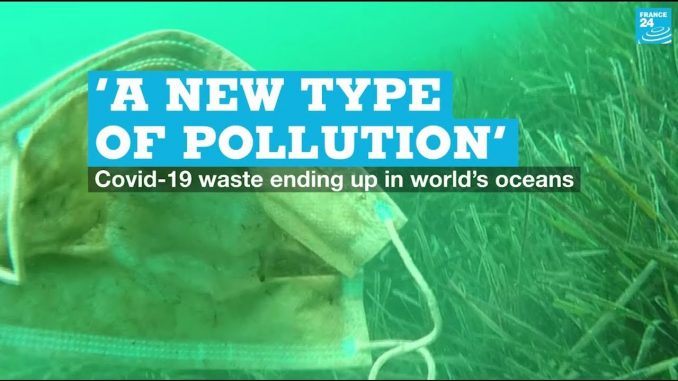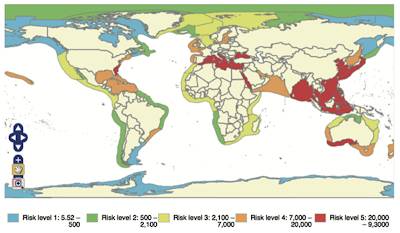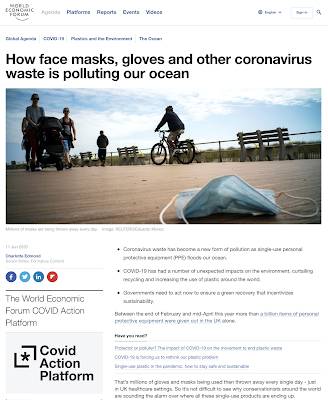
With masking becoming increasingly mandated the politicians among us who have clearly swallowed the COVID narrative, not surprisingly, a recent study shows that there is an unintended consequence to government's actions.
In June 2020, Joana Correia Prata and three other researchers authored a paper which was published by the American Chemical Society. The paper, entitled "COVID-19 Pandemic Repercussions on the Use and Management of Plastics" looks at the environmental impact of personal protective equipment or PPE being used during the COVID-19 pandemic. Let's start with some background first.
According to environmentalists, aside from global climate change, the presence of microplastics in the environment is considered extremely serious. Microplastics are defined as small pieces of plastic less than 5 millimetres long (about the size of a sesame seed) and are found in both terrestrial and marine environments. When larger pieces of any type of plastic are introduced into the ocean, over time, they break down into smaller and smaller fragments which contaminate the environment. Here is a quote from the National Ocean Service:
"Microplastics come from a variety of sources, including from larger plastic debris that degrades into smaller and smaller pieces. In addition, microbeads, a type of microplastic, are very tiny pieces of manufactured polyethylene plastic that are added as exfoliants to health and beauty products, such as some cleansers and toothpastes. These tiny particles easily pass through water filtration systems and end up in the ocean and Great Lakes, posing a potential threat to aquatic life."
Microplastics are also sourced from the larger plastic items that we use everyday and are also sourced from plastic microfibres that are shed from textiles in laundry, particularly from synthetic textiles including polyester.
These plastic fragments are eaten by minuscule crustaceans called zooplankton and are then carried up the food chain as larger and larger animals eat the animals below them on the food chain. Microplastics are found in all of the world's oceans as well as in terrestrial water bodies and the land itself. According to the Scientific American, injected micro plastic particles can physically damage organs and leach hazardous chemicals from the hormone-disrupting bisphenol A to pesticides that can compromise immunity and interfere with growth and reproduction of humans and other species.
Here is a table showing the common types of plastics found in the marine environment:
Here is a map showing the relative distribution of microplastics in the world's large marine ecosystems from a 2012 study:
Understandably, you might be asking yourself "What does government mandated masking have to do with the global marine environment?" Let's go back to the study by Joana Correia Prata et al. In the study, the authors note the World Health Organization estimated that the monthly needs for PPE among healthcare professionals would reach 89 million masks, 76 million gloves and 1.6 million goggles. In another case, it was estimated that Italy needed 1 billion facemarks and 0.5 billion gloves per month for a population of 60.4 million people. Extrapolating to a global population, an estimated 129 billion disposable face masks and 65 billion disposable gloves would be used monthly on a global basis. Over a six month period, this would result in the consumption and discarding of 784 billion face masks over a six month period or 1.548 trillion face masks on an annual basis. In las you should happen to think that these numbers seem high, keep in mind that the Canadian government, a nation with a population of 36 million people, has ordered 153 million N95 respirators, 18 million non-medical face masks and almost 400 million surgical masks. The province of Ontario has announced that a company in Vaughn, Ontario has ramped up its ability to produce one million N95 face masks every week.
Single-use disposable face masks are made of melt-blown fabric consisting of plastics including polypropylene, polyurethane and polyacrylonitrile. The majority of disposable face masks have two outer layers with a third filter layer made of nonwoven polypropylene. N95 masks are made of plastics including polypropylene and polyethylene terephthalate. Other disposable PPE such as surgical gowns and masks are made of non-woven materials which incorporate polyethylene, polypropylene and polyethylene terephthalate.
There is one additional aspect to microplastics that should concern all mask wearers. In 2019, researchers found that humans consumed between 39,000 and 52,000 microplastic particles per day. This increased to between 74,000 and 121,000 when inhalation of these particles is included. This means that human beings are ingesting roughly 5 grams of plastic (or the weight of a credit card) on a weekly basis. An August 2020 release on the American Chemical Society website found the following:
"…the researchers used another method called mass spectrometry to analyze 47 human liver and fat tissue samples. No materials were spiked into these samples. The team found plastic contamination in the form of monomers, or plastic building blocks, in every sample. Bisphenol A (BPA), still used in many food containers despite health concerns, was found in all 47 human samples." *my bold)
This begs the question; what is happening to mask users when they securely fasten a plastic-based facemask over their mouths and noses and wear it for hours on end, day after day? A 2005 study found that workers in a Turkish polypropylene processing plant experienced significant respiratory symptoms resulting from exposure to synthetic polymers which were inhaled as microscopic particulates or "flock". The flock was created as a result of the cutting process of the polypropylene which releases particulate material which is then inhaled by the workers and retained in their lungs. This resulted in occupational interstitial lung disease, termed "flock worker's lung" or FWL which has also appeared in similar manufacturing settings in Canada and the United States. Here is a quote from the Canadian study on flock worker's lung:
"The natural history of FWL includes the following patterns: complete resolution of symptoms (once the worker has left their occupation); radiographic and pulmonary function abnormalities; permanent, but stable symptoms and restrictive pulmonary function deficits; and progressive decline in pulmonary function, causing death from respiratory failure and secondary pulmonary hypertension. A low baseline diffusing capacity of the lung for carbon monoxide is associated with the persistence and progression of FWL. (my bold)
Just in case you think that you are not inhaling these plastic microfibres because you are using washable, reusable face masks, all that you need to think about is the lint trap on your clothes dryer after you've washed and dried a load of laundry. As well, since friction releases these microscopic fibres, it is likely that the continuous friction of breathing, talking and facial movements on the inside surface of a mask is releasing microscopic polypropylene and other plastic fibres into humans' lungs.
As is the case when governments get involved in a "project", there are often a series of unintended consequences. In the case of the unprecedented government-ordered universal masking, the release of microplastics into both the greater environment and our bodies could prove to pose a risk to both the global ecosystem and our personal health. While some PPE is being properly disposed of, even the World Economic Forum is admitting that COVID-19-related PPE waste is problematic for the world's oceans as shown here:
…and here:
Click HERE to read more from this author.
You can publish this article on your website as long as you provide a link back to this page.




Be the first to comment